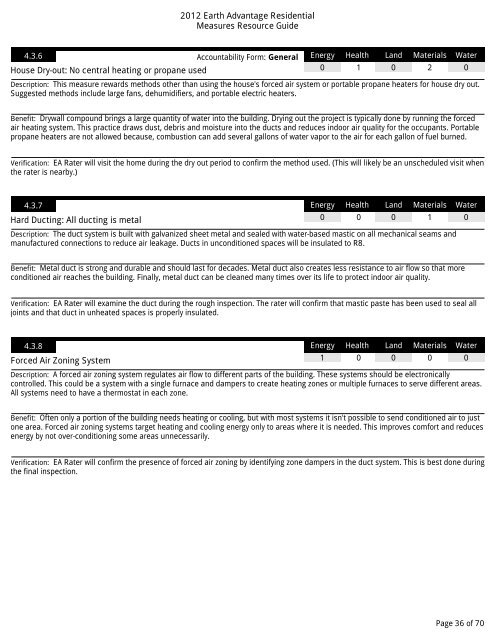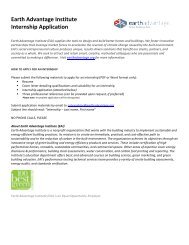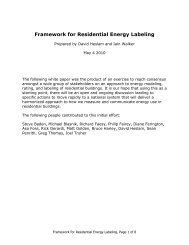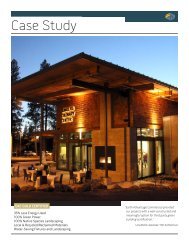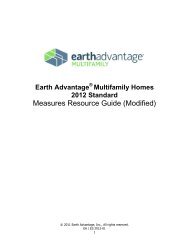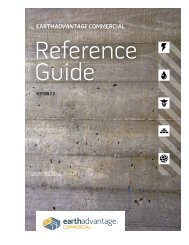EA New Homes Measures Guide - Earth Advantage
EA New Homes Measures Guide - Earth Advantage
EA New Homes Measures Guide - Earth Advantage
Create successful ePaper yourself
Turn your PDF publications into a flip-book with our unique Google optimized e-Paper software.
2012 <strong>Earth</strong> <strong>Advantage</strong> Residential<br />
<strong>Measures</strong> Resource <strong>Guide</strong><br />
4.3.6<br />
House Dry-out: No central heating or propane used<br />
Accountability Form: General<br />
Energy<br />
Materials<br />
Water<br />
0 1 0 2 0<br />
Description: This measure rewards methods other than using the house's forced air system or portable propane heaters for house dry out.<br />
Suggested methods include large fans, dehumidifiers, and portable electric heaters.<br />
Health<br />
Land<br />
Benefit: Drywall compound brings a large quantity of water into the building. Drying out the project is typically done by running the forced<br />
air heating system. This practice draws dust, debris and moisture into the ducts and reduces indoor air quality for the occupants. Portable<br />
propane heaters are not allowed because, combustion can add several gallons of water vapor to the air for each gallon of fuel burned.<br />
Verification: <strong>EA</strong> Rater will visit the home during the dry out period to confirm the method used. (This will likely be an unscheduled visit when<br />
the rater is nearby.)<br />
4.3.7<br />
Hard Ducting: All ducting is metal<br />
Energy<br />
Health<br />
Materials<br />
Water<br />
0 0 0 1 0<br />
Description: The duct system is built with galvanized sheet metal and sealed with water-based mastic on all mechanical seams and<br />
manufactured connections to reduce air leakage. Ducts in unconditioned spaces will be insulated to R8.<br />
Land<br />
Benefit: Metal duct is strong and durable and should last for decades. Metal duct also creates less resistance to air flow so that more<br />
conditioned air reaches the building. Finally, metal duct can be cleaned many times over its life to protect indoor air quality.<br />
Verification: <strong>EA</strong> Rater will examine the duct during the rough inspection. The rater will confirm that mastic paste has been used to seal all<br />
joints and that duct in unheated spaces is properly insulated.<br />
4.3.8<br />
Forced Air Zoning System<br />
Energy<br />
Materials<br />
Water<br />
1 0 0 0 0<br />
Description: A forced air zoning system regulates air flow to different parts of the building. These systems should be electronically<br />
controlled. This could be a system with a single furnace and dampers to create heating zones or multiple furnaces to serve different areas.<br />
All systems need to have a thermostat in each zone.<br />
Health<br />
Land<br />
Benefit: Often only a portion of the building needs heating or cooling, but with most systems it isn't possible to send conditioned air to just<br />
one area. Forced air zoning systems target heating and cooling energy only to areas where it is needed. This improves comfort and reduces<br />
energy by not over-conditioning some areas unnecessarily.<br />
Verification: <strong>EA</strong> Rater will confirm the presence of forced air zoning by identifying zone dampers in the duct system. This is best done during<br />
the final inspection.<br />
Page 36 of 70


